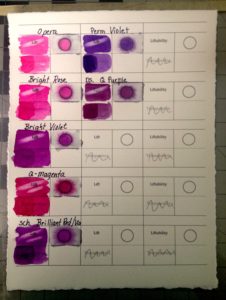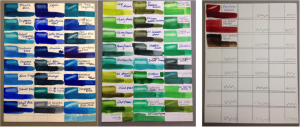Update – New grid pattern to my Watercolor Logbook.
Best Tool Ever, Paint Log – Here is a sample for the grid I like to use to make my paint log. I always use an 8 ½” by 11” piece of 140# Cold Press Arches paper, so I know how the paint will react when I actually use it for a painting and because it fits nicely into a plastic sleeve in a notebook. I like this pattern because I can get 15 to 18 different paints per page.
Click here for the Grid Pattern – Paint Log Book Grid

New Directions for above grid.
DIRECTIONS FOR LOG
Using a permanent Sharpie, draw the grid lines and circles where indicated.
Using a pencil, make squiggle line in the Transparency box.
Write the brand and name of paint.
Wet the entire box with the circle in it, let the water settle in.
Mix up a mid value paint and water mixture of the paint you’re testing.
Paint wet into dry in the lift/stain box and the transparency box.
Paint just inside your previously wet circle after the water has settled in but has not started to dry. This is how you can find out if your paint moves or stays where you put it. Also if it is granulating, or separating as some paints that are mixtures do.
Let it dry
Paint a second layer of color half way over your transparency box.
Use a stiff brush in the lift/stain box to try to lift the paint.
Use the notes section for other characteristics you notice about the paint.
_______________________________________________________________________
A Watercolor Logbook – This is by far my favorite watercolor tool besides paints, brushes, and papers. Pics of my old logbook.

My watercolor logbook has a sample section with information of every watercolor paint color I’ve tried.
The watercolor logbook tells me:
- The name of the color of the paint
- The brand name of the paint
- The difference of the colors between the brands.
- The actual color of the paint in a light, medium, and dark value
- How transparent is the paint
- How easy is the paint to lift
- If the paint is staining
- If the paint is granulating
- If the paint is shiny
- If the paint is dull
- How the paint feels (waxy, oily, watery)
Voila! You’ll be surprised how much you can learn from this simple color log.
